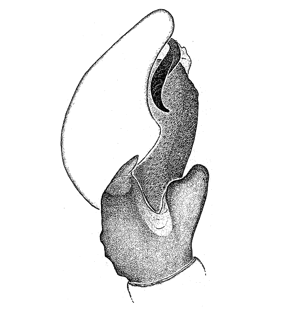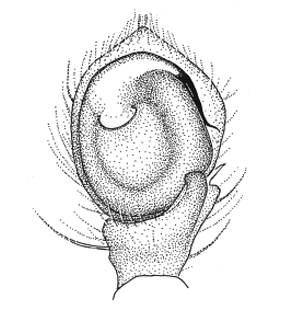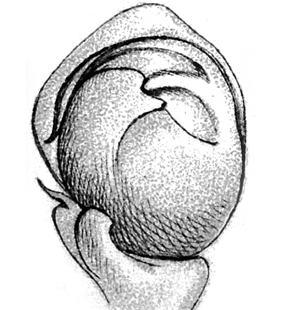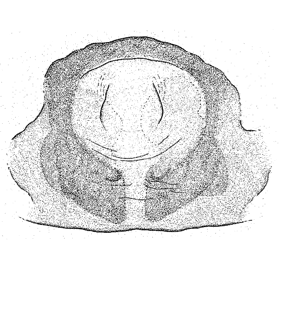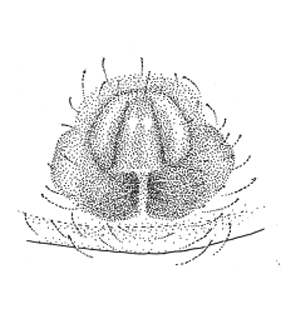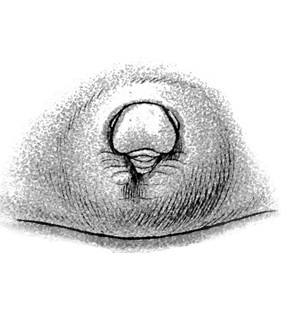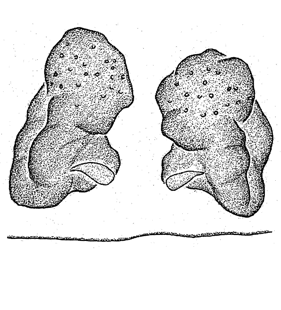Bassaniana baudueri (Simon, 1877)
Description
Male
Tibial apophysis with ventral, broad, hook-shaped and distally rounded apophysis and a second one, originating retrolaterally, with tooth-like process. Embolus short, rectangularly projecting distally. Epigyne has a clip-like protrusion vertically, no epigynal groove. Vulva with 2 sac-like structures separated from each other. Prosoma black-brown, and in median and posterior field with spotted and V-shaped, white pattern. Sternum black-brown, black-brown margin. Female: scarcely spined. Chelicerae black-brown, strongly patterned yellow cream-coloured. Legs short and thick with dense, robust spines, spotted very dark and contrast-rich (white, black, brown) like remaining specimen. Opisthosoma anteriorly black, brown, spotted grey and cream-coloured, becoming brighter posteriorly. Female: with median lancet-like brightened area or posteriorly with inverse cream-coloured, triangular field. Spinnerets brown.
Prosoma brown, with white spots. Prosoma length: 1.95-2.1 m. Chelicerae and sternum brown, with white spots. Legs yellowish with brown and white spots, femora I and II sometimes completely brown on ventral side. Opisthosoma with variable pattern, but at least a white anterior spot on each side.
Body length male: 3.8-4.5 mmFemale
Prosoma length: 2.55 mm. Colouration as in males, but lighter.
Body length female: 5.0-6.75 mmAdditional information
under bark of trees, camouflaged due to its colour
Distribution
Phenology
| Jan | Feb | Mar | Apr | May | Jun | Jul | Aug | Sep | Oct | Nov | Dec |
 |  |
Figures
Distribution List
"No references" does not mean that the species does not occur in this country, but that we have not yet inserted the reference for it. We are working on it.
References
Breitling R, Bauer T, Grabolle A, Oger P, Pantini P, Van Keer J, Pfliegler W P, Jantscher E, Dolanský J (2016a) East meets West: on the true identity of Cheiracanthium rupestre and Xysticus albomaculatus (Arachnida: Araneae: Eutichuridae, Thomisidae). Arachnologische Mitteilungen 52: 38-49 ![]()
Chyzer C, Kulczyński W (1891) Araneae Hungariae. Tomus I. Academia Scientarum Hungaricae, Budapest, 170 pp., 4 pls. ![]()
Déjean S, Ledoux J-C (2013) De araneis Galliae, III, 4: Bassianiana versicolor baudueri (Simon, 1932). Revue Arachnologique 17: 88-92 ![]()
Jantscher E (2001a) Revision der Krabbenspinnengattung Xysticus C.L. Koch, 1835 (Araneae, Thomisidae) in Zentraleuropa. Dissertation, Univ. Graz, 328 pp., 81 pls. ![]()
Otto S (2022) Caucasian spiders. A faunistic database on the spiders of the Caucasus Ecoregion. Database version 02.2022. Internet: caucasus-spiders.info.
Samu F, Szinetár C (1999) Bibliographic check list of the Hungarian spider fauna. Bulletin of the British Arachnological Society 11: 161-184 ![]()
WSC (2025) World Spider Catalog. Version 26. Natural History Museum Bern, online at http://wsc.nmbe.ch (28.2.2025) doi: 10.24436/2 ![]()
